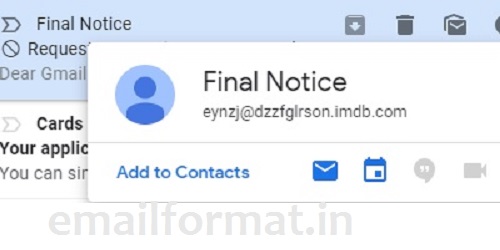Resignation Email Format
Resignation email format is very important in order to cover all the areas which are associated with your resignation.
Professional resignation email format will help you to smooth transition of your exit process.
Who Do You Send Job Resignation Email To?
You must know to whom you are submitting the resignation email. Generally your immediate reporting manager is the
person to whom you submit your resignation email. For email format, you can use 'To' field to mention email id of your manager.
To: Your Reporting Manager
Copy Of Resignation Email
You should also know the Human Resource (HR) manager to whom you are submitting the copy of resignation email.
HR manager is the person to whom you submit the copy of your resignation email. If you don't know the HR manager then
you can ask your reporting manager for the same. It is absolutely important that your HR manager is notified about
your resignation email. For email format, you can use 'CC' field to mention email id of the HR manager.
CC: Your HR Manager
What is a good subject line for resignation email?
Subject of resignation email should be self explanatory. I have received many resignation emails till now in my career.
All of these resignation emails were in resignation email format instead of physical or hard copy of the resignation email.
Subject: My Resignation
Resignation email Format
Resignation email format for writing a resignation email does not require any creativity,
just state the position you’re resigning from and the effective date.
Resignation email email need not describe the reasons for leaving, you should
discuss it with your reporting manager or boss before you are sending the simple resignation email email.
Keeping it simple resignation email is perfectly fine. Resignation email also gives you the opportunity
to say thanks to the organization. Additionally, you may offer to help find your replacement,
or agree to finish certain projects and tasks before your last day in the resignation email email.
Below are the sections of the email that you can use to draft yours.
Section 1: Describe yourself
Start your email by stating your position (designation), and the organization. This is necessary since the
email is your official termination, it’s important to include. Then, follow this information with a
simple statement of your resignation.
Section 2: Mention on the positives
Mention about how you’ve grown, what you’ve appreciated most about your time at the organization.
Reflect the professional development opportunities, appreciate organization culture, and the support that you received.
It is nice for your manager or employer to receive a thank you for the time and resources they have used to support your career growth.
Section 3: Where you are headed next (optional)
This is an optional section and need to mention if you are switching organization to pursue a passion,
or going for higher studies. However, you do not want to mention this section if you are leaving the organization for a competitor.
Section 4: Propose to assist in the transition
In this section, mention your willingness to make the transition smoother or easier.
It’s impressive if you include specific details regarding how you’ll help in transition.
Section 5: Outline your workload & last day at work (optional)
This is an optional section and briefly review the work you'll be surrendering when you officially leave the organization.
This will help your manager to prepare your replacement to pick your work and determine how it will continue to achieve the project goals.
List all the projects and tasks you've been in charge of to make the transition even easier.
Providing an end date in this section is helpful, since that’s one of the first questions your employer
is going to have. You may wanted to have early exit and hence to mention it here will be helpful.
Let's see how a simple yet professional resignation email format looks like considering above steps.
Dear [Sir/Madam or mention name of your manager],
This is to inform you that I am resigning from my position of [your designation], for [company name], on [date of resignation email].
I really appreciate the experience and growth opportunities I have gained while working with [company name]. Thank you for all the support.
If I can help in any way to ease the transition, please let me know.
Please accept this email as formal notification of my resignation and let me know if I can get early release by [date].
Thanks,
[your name]
Don't forget to resign in the organization system or portal
If your organization is having a on line system or portal where employee needs to submit their resignation, then
you must complete it before you are sending resignation email email to your manager.
Mention about your resignation in organization system or portal
If you have submitted your resignation in the on line system or portal of your organization, then you can mention
about it in the resignation mail. Few employees may want to attach the screen shot of the portal where they have resigned.
It is ok to attach the screen shot.
I request you to approve my resignation on organization portal and allow me to move.
Structure and Formality Differences between Letter and Email
Resignation letters follow formal business letter format with addresses and signatures, while emails are more concise with just salutation and closing. Letters maintain traditional structure on company letterhead, whereas emails use standard email formatting with subject lines and digital signatures if needed.
Delivery and Documentation between Letter and Email
Letters are typically printed and hand-delivered or mailed, creating physical documentation. Emails provide instant digital delivery with timestamps and read receipts. While letters may be scanned later, emails exist natively in both parties' records from submission.
Content Length and Tone between Letter and Email
Letters allow for slightly more detailed content due to their formal nature, while emails should be more concise. The tone in emails can be marginally less formal but should maintain professionalism. Both require clear resignation statements and notice periods, but emails may omit some traditional letter elements.
I hope the above Resignation email format has helped you in drafting your professional resignation email.
Additionally, you can refer to resignation email samples here
People who viewed this also viewed 'real Resignation Email Samples'
Share This Page






